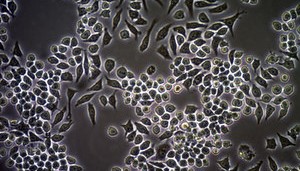Immortalized Murine Cells
 Murine cells show frequent spontaneous immortalization in contrast to human cells that almost never spontaneously immortalize. Addition of DNA tumor viruses alone, mild mutagen treatments and even deregulated expression of cellular genes such as c-myc are enough in certain murine cells for immortalization. Crisis stage is either not observed or is very subtle in case of murine cells, due to their ability to immortalize spontaneously, were exploited to identify genes associated with cellular mortal or immortal phenotypes. Independent studies on spontaneously immortalized clones from different strains of mouse have shown that most of these clones had one or both mutant p53 alleles, in contrast to their parent cells which expressed wild type p53. The immortal clones which expressed wild type p53 were found to be defective in one or other elements of the pRb pathway.
Creative Bioarray can provide you immortalized murine cell lines with an integrated platform for meeting the needs for virtually any relevant research project.
Murine cells show frequent spontaneous immortalization in contrast to human cells that almost never spontaneously immortalize. Addition of DNA tumor viruses alone, mild mutagen treatments and even deregulated expression of cellular genes such as c-myc are enough in certain murine cells for immortalization. Crisis stage is either not observed or is very subtle in case of murine cells, due to their ability to immortalize spontaneously, were exploited to identify genes associated with cellular mortal or immortal phenotypes. Independent studies on spontaneously immortalized clones from different strains of mouse have shown that most of these clones had one or both mutant p53 alleles, in contrast to their parent cells which expressed wild type p53. The immortal clones which expressed wild type p53 were found to be defective in one or other elements of the pRb pathway.
Creative Bioarray can provide you immortalized murine cell lines with an integrated platform for meeting the needs for virtually any relevant research project.
Description: IMPE is a conditionally immortalized mouse pancreas epithelial cell line isolated from the mouse ...
Description: MSIE is a conditionally immortalized mouse small intestine epithelial cell line isolated from the ...
Description: The epididymal epithelium plays an important role in male fertility by supporting sperm motility, ...
Description: ImHep is a conditionally immortalized mouse hepatocyte isolated from the mouse harboring ...
Description: The Immortalized Rat Retinal Precursor Cell Line (R28) is derived from postnatal day 6 ...
Description: Clara cells play a role in the maintenance of normal bronchiolar epithelium by secreting Clara Cell ...
Description: Müller cells are glial cells in the vertebrate retina responsible for the homeostatic and metabolic ...
Description: Nonciliated bronchiolar (Clara) cells, alveolar type I and type II cells are the predominant cell ...
Description: The Immortalized Rat Conjunctival Epithelial Cells (CJ4.3) were derived from primary conjunctival ...
Description: The epididymal epithelium plays an important role in male fertility by supporting sperm motility, ...
Description: Microglia cells are resident macrophages of the brain and spinal cord and they act as the first and ...
Description: The corpus luteum develops from an ovarian follicle during the luteal phase of the menstrual cycle ...
Description: The cementum is a mineralized tissue lining the tooth root surface and shares many properties with ...
Description: Schwann cells are valuable tools for diabetic neuropathy pathogenesis involving glycation, reduced ...
Description: Schwann cells are valuable tools for diabetic neuropathy pathogenesis involving glycation, reduced ...
Description: The Immortalized Rat Sympathoadrenal Progenitor Cells (MAH-A3) are derived from HNK-1+ cell ...
Description: The decidual cells play an important role in the maintenance of pregnancy at the maternofetal ...
Description: The Immortalized Mouse Embryonic Hepatic Progenitor Cells are non-tumorigenic, ...